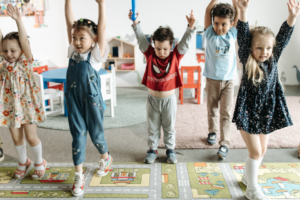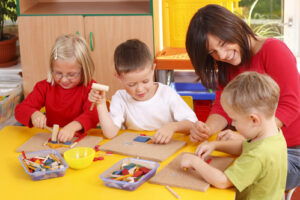
5 Fun Autumn Crafts for Preschoolers
 Because both the preschool years and autumn are full of changes, fall is a wonderful theme to explore with these youngsters. They delight in observing, seeing, describing, touching, and playing in the vibrant fall leaves. These crafts are intended for ages three to five, but could be simplified and differentiated for children of a younger age and may be enjoyed by any older child (or adult).
Because both the preschool years and autumn are full of changes, fall is a wonderful theme to explore with these youngsters. They delight in observing, seeing, describing, touching, and playing in the vibrant fall leaves. These crafts are intended for ages three to five, but could be simplified and differentiated for children of a younger age and may be enjoyed by any older child (or adult).
1. Leaf Creatures
Leaves come in many wonderful shapes and with the use of preschoolers’ ripe pretending skills, the shapes can be imagined into other forms. Much like the common, “What does that cloud look like?” game, leaves can also be turned into animals, people, or houses. This activity can begin with leaf collecting and comparing, with a discussion of how different trees produce different types and shapes of leaves. The teacher can pre-make cardboard cutout shapes of some common leaf types for children to trace on their paper. Then, with teacher encouragement, children can turn their leaf shape into something new (i.e. draw legs and a tail to make it a cat). Sharing a simple teacher example of a leaf shape turned into a dog or turtle helps the children get started. Be sure to ask them what they’ve made their leaves into and encourage them to try write it down or co-write it with you, or you can write it for them. Another variation of this activity is to let the children makes leaf rubbings to work with or to ask the children to glue actual leaves down in the shape of a person or animal of their choosing. The leaf artworks can be further decorated with markers, paint, or collage materials. Kinderart offers a fun “Leaf People” lesson in which sticks and paper are included.
2. If I was a Leaf/ My Favorite Leaf
While learning about leaves, children can sort real, paper, or plastic replica leaves by shape and color. Children can vote on their favorite kinds of leaves. Children can then be encouraged to pretend they can become their favorite leaf, or that they can make up their own kind of leaf to pretend to turn into. Using salt dough clay or another kind of clay that is easy to dry or bake, children create their favorite leaf or the leaf they would like to become out of clay. If you want children to have leaf necklaces, poke holes in them before they dry. Once the leaves are dried or are baked or fired, children can paint them in any colors they choose. While encouraging children to make their own leaf shapes as they see fit promotes their creative expression and imagination, side activities such as using leaf cookie cutters in play dough or making leaf prints in clay are also fun.
3. Illustrated Leaf Flying Stories
Watching leaves fall and fly in the wind, dancing like leaves inside, and running like leaves outside are all simple and delightful activities to introduce to young children. After children make the leaf they’d like to be (or make their favorite leaf), read the book, “The Little Yellow Leaf,” by Carin Berger which tells the tale of a leaf that is afraid to leave its branch. Later on, it meets another waiting leaf, and they jump together and fly off to have wonderful adventures. Encourage children to tell you and then draw where they would like to fly to if they were a leaf who could fly anywhere. Tell them where you would fly if you were a leaf if they need help grasping the concept. Children can also write or dictate their ideas to you. Children’s leaf adventure drawings and stories can be bound into a class book–make copies for each of them or let them take turns bringing a class copy home.
4. Paper Bag Trees
As well as learning and thinking about the falling leaves, it’s important to give the trees themselves attention as well. Looking at pictures of trees in different seasons is a great place to start and classes can also discuss the roots, trunk, branches, and leaves of a tree and identify them outdoors. Teachers should prep paper bags for this craft by opening them and then twisting the top half of them until they are gathered together. Then, cut strips down into the twisted area (not past it—the bottom half will be the trunk). Children can help with the next part: these strips of paper now need to be twisted which makes them branches. The strips can be twisted individually or in groups of two or three. Show the children how to hold, squeeze, and turn the paper a little without tearing off the branches–if you are working with very young children, sticking to squeezing will be easier than twisting and works fine too. Teachers can pre-cut some fall-colored tissue paper into tear-able sizes and let the children tear or cut off pieces, depending on their dexterity and preference, and glue the pieces as leaves onto their trees. A fun way to supersize this project is to make a large class tree in this style out of newspaper and then let children paint the trunk and add the leaves together.
5. Apple Printing
As part of learning about apple trees, orchards, apple harvests, and autumn, preschoolers can print or stamp with real apples. It’s a great idea to save some apples for eating as well or to make applesauce or apple pie the same week. Giving children (in smocks) halved and quartered apples to stamp with is usually a big hit. Incorporate a color study by having the children mix red and yellow paint to make orange. You can incorporate language skills into this apple printing craft by teaching the children to say the Spanish word for apple, manzana, and having them write both apple and manzana or just an “A” for apple, depending on their literacy level.
Spending fall learning and making with preschoolers is a sometimes messy but fun and special gift because of their joy and enthusiasm for learning about the world around them.
Written by Julia Travers
Contact us today to learn more about how our tutors can help your child before preschool and kindergarten!
Tag:crafts



